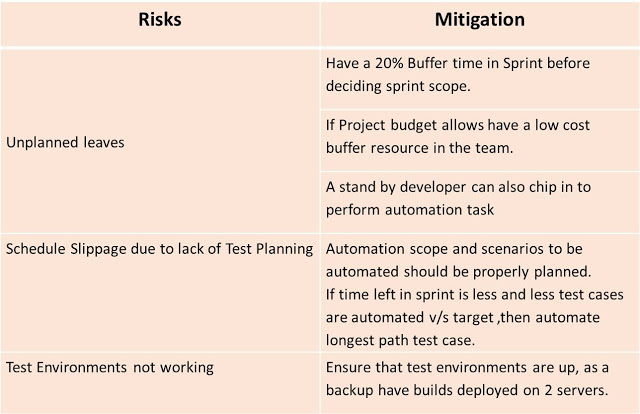Introduction
- Define Automation Test Strategy in Agile based Product Development. For version 1.0 Release.
- Define Risks & Mitigation Plan
- Product Development is done using Agile-SCRUM Methodology
- Product is a web based application.
- Definition of “Ready” for User Stories is met before Sprint Starts.
- The First Release is tagged and labelled as Version 1.0
- One Milestone constitute of 3 Sprints
- One Sprint is of 10 working days.
- 0% Automation Coverage is achieved but needs to be increased, however keyword driven framework is adopted based on objects.
- Automation Tool is Finalized and considered in Project Kick-off.
- Development Team combination is of 6 Developers and 3 QA.
- Continuous Integration (CI) is adopted.
- Objective:
- To prepare an Automation Test Strategy that could achieve maximum automation
- To meet the deadline
- To ensure quality and meeting acceptance criteria
- Proposed Solutions:
- Adopt Parallel Approach
- Adopt Lagging Approach
- Solution I- Parallel Approach
- The objective of this Approach is to perform Development of User Stories and Automation of User Stories in the same Sprint parallely
- The Test team starts automation/script created based on designs, screens and mockups.
- The Test team executes the scripts created on the build and notifies by logging bugs either in the same week or next week (In the same sprint)
- This can be better explained in the next diagram
Risks and Mitigations
- Solution II- Lagging Approach
- The objective of this Approach is to perform Development of User Stories in Sprint n and Automation of User Stories in the n+1 Sprint
- The Test team starts automation/script created based stability of user stories delivered in Sprint n
- The Test team performs Manual Testing in Sprint n
- The Test team executes n-1 Sprints scripts i.e scripts of previous sprint
- However in this approach 100% automation for Release 1.0 is not achieved
- This can be better explained in the next diagram
To know more email: marketing@calsoftinc.com
Contributed by: Sagar Abhyankar| Calsoft inc







